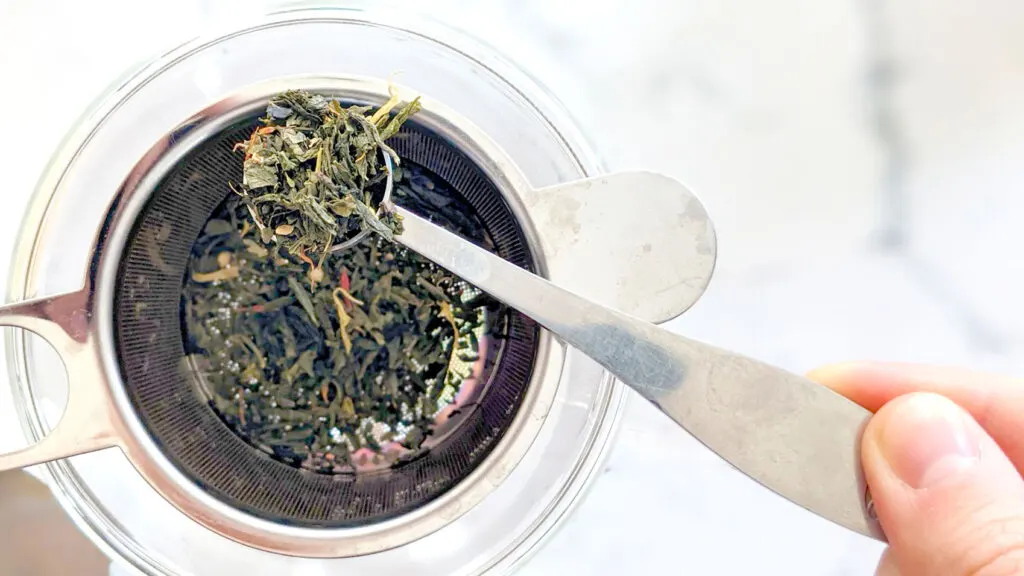Tea tasting is a fun way to get into the different types of teas, expand your palette, or bond over tea with friends and family.
The great thing about tasting tea is that it can be whatever you want it to be. You can be a beginner or expert tea taster, it’s all about what you taste! There’s no right or wrong answer when it comes to tasting tea.
Here are some steps for how to start tasting tea, some aroma and flavour suggestions, and more!
Psst! This blog post contains affiliate links in it which sends me a bit of extra money if you use them… at no extra cost to you!
What Is Tea Tasting
Tea tasting can be whatever you want it to be. It can be a way to practice mindfulness every morning with your daily cup… For example, take 5 minutes to think to yourself what your tea smells like, tastes like, and how it makes you feel.
Tasting tea isn’t only about taste, it’s about engaging all our sense: sight, smell, taste, and even touch! It’s a way to expand you palette – to encounter new aromas and tastes you never knew existed.
Like I said, you don’t have to be an expert tea taster – it’s about what you think it tastes like and no one else! If you’re tasting tea in a group, it’s a way to grow and bond together.
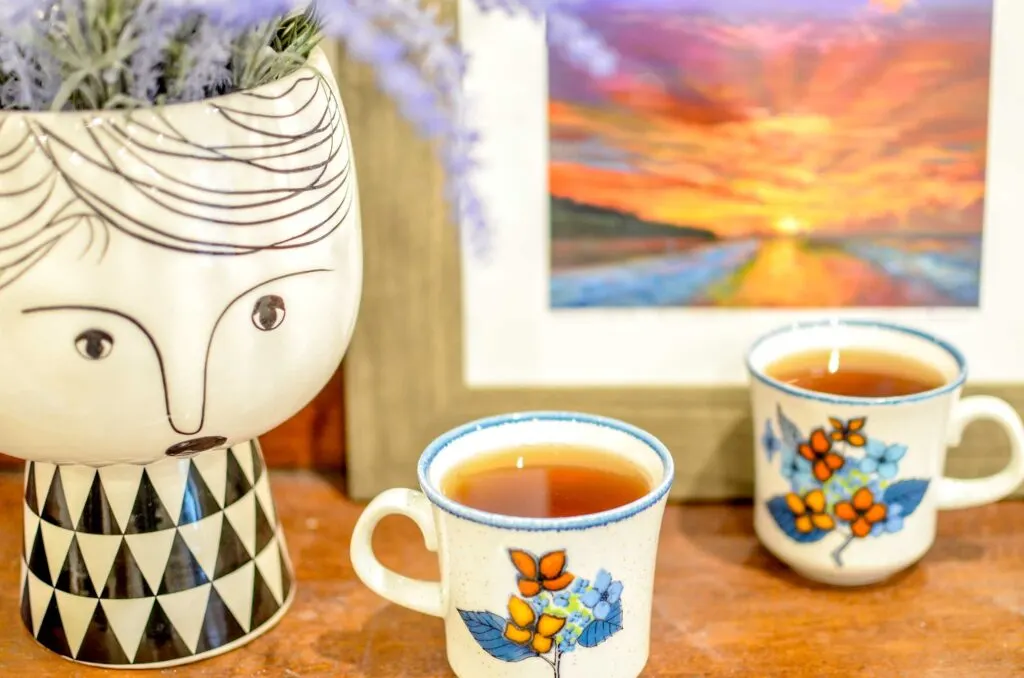
What Is Gong Fu Cha Tea Tasting Ceremony
The Gong Fu Cha ceremony is the traditional Chinese tea tasting ceremony. You would have a Gong Fu tea tasting set (more on that in a bit) and follow more strict steps to taste tea.
But again, the Gong Fu Cha ceremony is not about tasting the tea, it’s about being mindful about what you’re drinking. It’s a process about tea appreciation. But you can strip down the ceremony and still taste tea without the entire set.

Love Earl Grey Tea!?
Then you have to try Firebelly Shades of Earl Grey – it uses REAL bergamot! Check it out here!
What You’ll Need To Taste Teas
All you really need to taste tea is a mug, some tea, and an open mind. You can invest in all these fancy tea tasting Gong Fu sets – which you still can – but you don’t need to. Especially if you’re just starting out or want to have some fun with friends, you don’t need anything at all.
P.S. whichever method you choose, white ceramic tea cups are recommend so you can take notes and get an accurate colour of the tea liquor.

Some Tea, A Mug, & Yourself
If you’re just starting out with tea, start off with the basics: some tea, a mug, and yourself. Just follow the tea tasting steps below for how to taste a cup of tea.
If you want to do several infusions, just don’t fill up your mug the entire way. Pretend as though it’s a small tea cup you’re drinking out of!
Teacups & Teapot Or Gaiwan
If you want to take your tea tasting to the next level, you can invest in a few simple items. For starters, it’s always good to have a kettle with temperature control (I like my Cuisinart from Amazon).
You should also have a small teapot with teacups for everyone in your tea tasting ceremony. You can also invest in a Gaiwan, a traditional tea brewing cup (like this on Amazon) instead of a teapot.
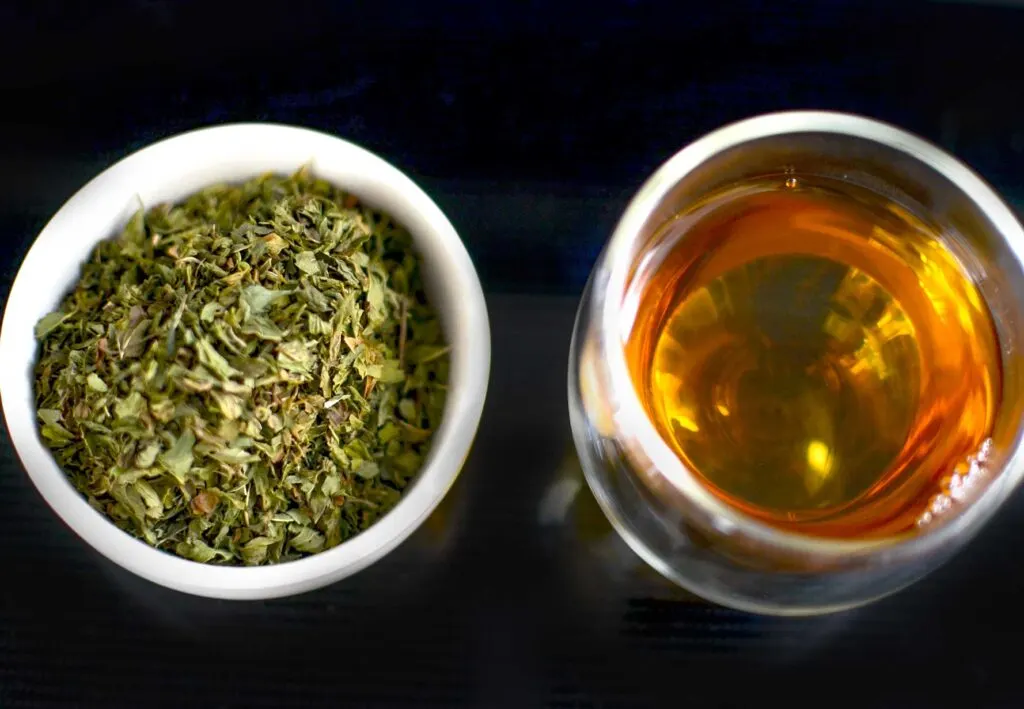
Gong Fu Chat Set
Take your tea tasting one step further, and invest in a Gong Fu Cha set, but these are definitely harder to find. You need a bamboo board (like this one on Amazon) to pour your water out into, a tea pet (for support!), a teapot, as well as a reserve teapot, and of course teacups for each tea taster.
If you’re tasting tea with others, you should also have a serving pot. You’ll need one teapot to brew the tea, and then you’ll pour that tea into a serving pot before pouring into individual teacups. This is to make sure that everyone gets an even brew.
If you poor directly from the teapot, the first cup will be much lighter than the last cup. You can alternatively, take from Japanese ceremonies and pour your teapot evenly into all the cups. So pour a bit into the first teacup, then the second, and so on before going back to finish off every teacup…

No Matter Which Tasting Method – Always Have A Tasting Journal
The best way to improve your palette and your tea tasting muscles is to have a tea tasting journal (like this one on Etsy!).
You can record everything about the tea – the look of the dry leaf, the smell, the look and smell of the wet leaf, and of course the taste of the tea. There’s also room to take notes if there’s anything you want to remember about the moment you tasted this tea – because again, it’s about you and your experience.
It’s a fun activity to record your tea tasting notes, and this way you have a record of all the teas you’ve tried. It’s also a good way to compare and reference teas later on. It’s always easier to compare tastes than to come up with something new.
Plus you can go back to see how your palette has changed from the beginning of your tea tasting journey and if you can see an improvement.

And Have A Tea Tasting Guide For Reference
As I said, it’s always easier to compare than to come up with something new. When you’re just started out tasting tea, have a guide with some tasting notes you can reference (like this one on Etsy).
It gives examples for every tea flavour and aroma. Plus, a second page comes with examples for the shape of the leaf, textures and mouthfeel, and how it could make you feel after drinking it.
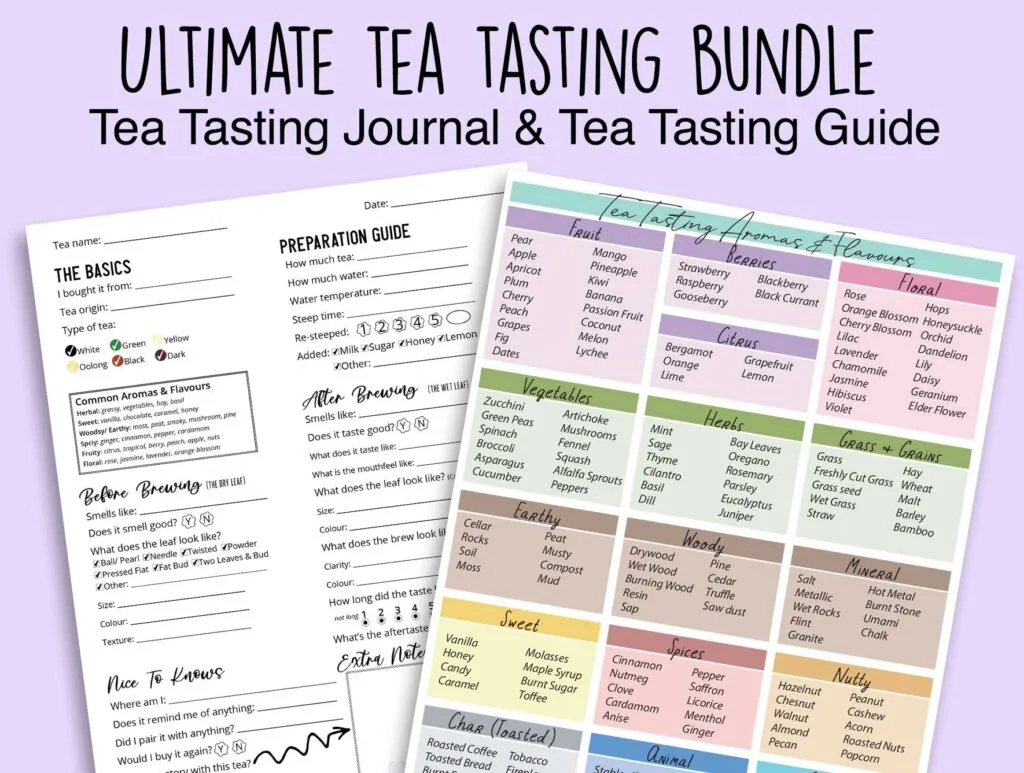
Interested In Tea Tasting? Get The Tea Tasting Bundle!
Refine your tea palette with my Tea Tasting Guide and take notes on every new tea you try to remember for next time in my Tea Tasting Journal.
P.S. Use my code ATRLOVE for an extra discount on my Etsy Shop!

Before Beginning – Some Tea Tasting Tips
Try Tasting Tea In Silence
Tasting tea is about tapping in to all your senses. To enhance your taste and smell, and remove any distractions, try your tasting in silence.
This way, you can really focus on the tea you’re tasting and create your own opinio. If you’re with others, have a moment of silence to collect your thoughts, and then discuss with them. This removes any influences others might have on you.
You can also try to taste teas with your eyes closed (although this is easier said than done!). When you see the brew, you automatically make assumptions about it – based on colour, thickness… If your eyes are closed, you’ll be void of any pre-conceptions about the tea. Now you can fully focus on the taste of the tea and nothing else.

Choosing The Right Tea
If you’re just starting out on your tea journey, start simple with flavoured teas. These have a lot of aromas so it will start to train you to pick up the different notes.
Once you start to understand flavours and can pick up on more subtle notes, you can expand to teas like oolong and black tea.

Keep Track Of Your Teas
Never forget the tea in your cupboard with my printable & digital tea tracker. Comes in a visual cupboard design or list view!
More About Smell Than Taste
Before even starting to taste teas, it’s important to understand how tasting works.
Our nasal cavity is connected to our mouths. So almost all what we taste is actually the aromas we smell (before and during drinking). This is called retronasal Olfaction – the ability to smell food as it passes through our mouth.
Before actually tasting your tea, learn how to properly smell your tea. There are three ways to smell your tea…

Direct Olfaction
Direct Olfaction is simply breathing normally. You won’t actually smell that much through direct Olfaction though. As it turns out, our body has a defence mechanism against odour and harmful chemicals, so we only get about 10% of the aromas by smelling the tea leaves this way.
It’s good to start your tea tasting with direct Olfaction – by breathing over the dry and wet leaves. But then you’ll need to graduate to more complex smelling methods…

Taste Tea Where You Are!
Taste tea on the go with my pocket size tea tasting log book on Etsy.
This printable digital download tea tasting journal also comes with a tea tasting guide inside.
Sniffing To Smell The Aromas
To get more of the tea aromas, the next step will be to sniff the moistened tea leaves. Sniffing tea involves taking short and sharp breaths, quickly and repeating as much as needed.
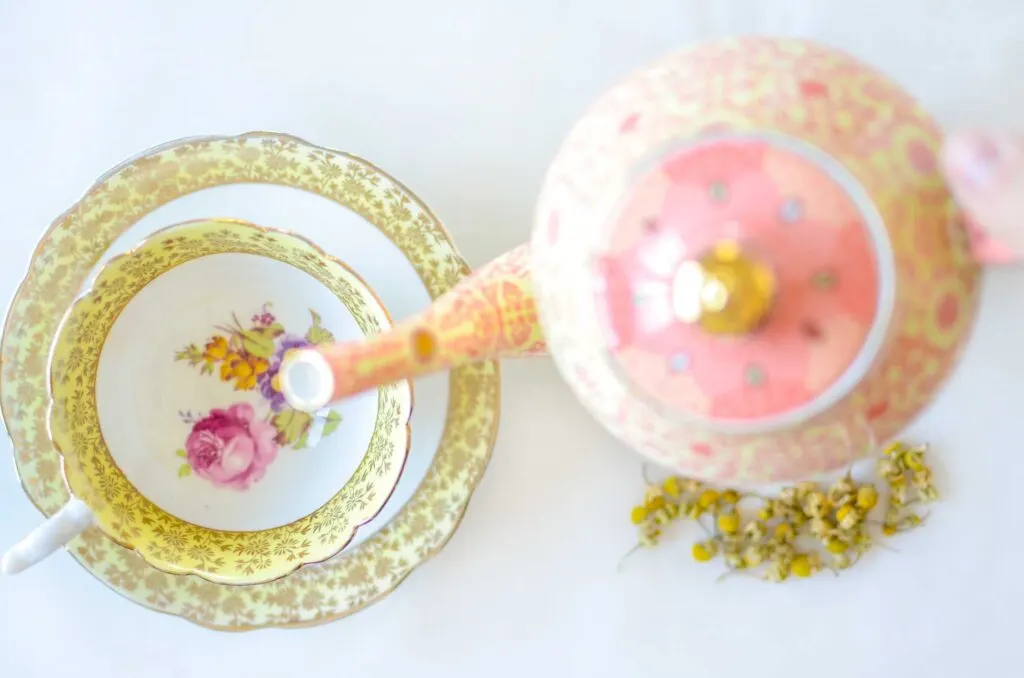
Retronasal Olfaction
Retronasal Olfaction is the most complex way to smell your tea. You’re actually going to be smelling through your mouth – remember, I said it’s all connected!
This takes a bit of practice but take some steeped tea into your mouth and exhale through your nose. Instead of tasting the tea leaves with your taste buds here, you are actually smelling them.
Retronasal Olfaction Fun Fact
You know when you don’t like the taste of something (maybe some grape medicine as a kid?) and you would block your nose before you swallowed. This is why! When you block your nose it dulls the flavours because most of the taste is from the smell.
Try doing this with your tea! Not because you hate the taste this time, but to be able to differentiate between nasal smells and tastes in your mouth.
You can also enhance the “taste” of your tea during Retronasal Olfaction. To do this, slowly exhale through your nose with tea still in your mouth. When you exhale through your nose, you actually inhale air through your mouth. This will heighten the smells to 100% – if you can pull it off!
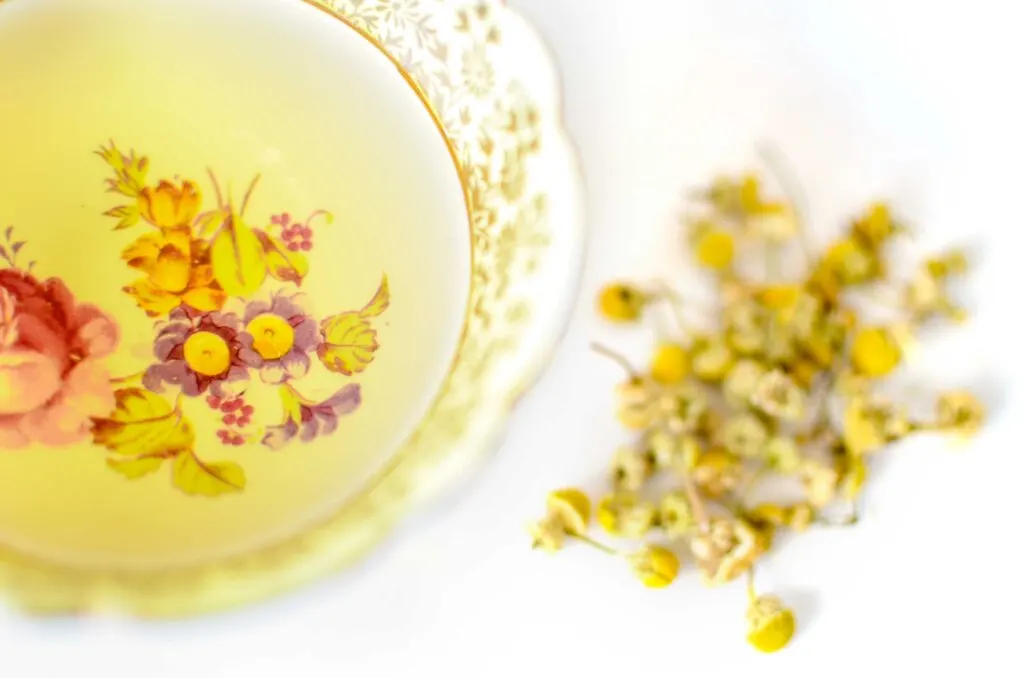
To Slurp Or Not To Slurp When You Taste Teas?
You may have noticed that when professionals taste tea they tend to slurp it into their mouth. They’re doing this to aerate the tea, adding oxygen to it, and to cool it down. Apparently this will enhance the flavours even more.
The reality is, that it adds so little to the flavour of the tea that you don’t need to slurp it. If you find that it cools it down so you can drink it faster, then by all means, slurp away!
Alternatively, you can also swish it around in the cup before, or even in your mouth. This way it also fully covers your mouth and all your tastes buds in the process!
It’s a good experiment to do while tasting tea to see if you notice a difference in flavours and see which one you like better.

Taste Tea Where You Are!
Taste tea on the go with my pocket size tea tasting log book on Etsy.
This printable digital download tea tasting journal also comes with a tea tasting guide inside.
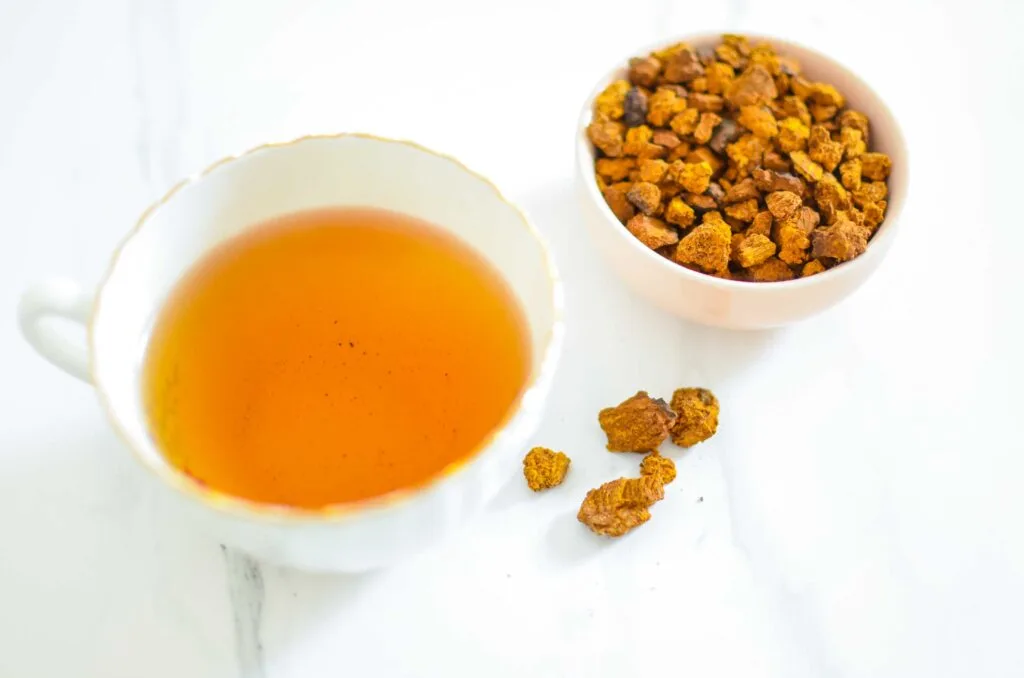
Going Beyond Flavours
Figuring out the flavour of the tea is a great way to get started. But once you become a more advanced tea taster, you can delve into the nuances to figure out the quality of the tea. In this case, quality of tea is seen by looking at mouthfeel, whether or not a tea lingers…etc.
A great way to get into the nuances of the tea is to do a side by side comparison of two similar teas. So for example, compare two black teas, or a green tea tasting.
This way, they should have similar flavours but some thing else might stand out to you.

How To Taste Tea – A Virtual Tea Tasting Guide
There are 5 main phases to tea tasting:
1. Analyze The Dry Leave
The first step in any tea tasting is to analyze the dry leaf. You’ll want to look at it, you can even feel it, and finally smell it.
Take note of the the size, colour, and all around look of the leaf.
Tea Tasting Notes & Guide
You might be interested in my digital and printable tea tasting notes & guide to take your tea tasting to the next level. See it on Etsy.
How To Smell The Dry Leaf?
You wont be able to smell the dry leaf it if it’s cold. Fill up an empty cup with warm water, spill that out then put the dry leaves inside. Cover it for a few minutes. (This is where a Gaiwan is useful because it comes with a cover – but you can also get this silicone cover on Amazon here).
Once the leaves are warm, you can smell the cover of the Gaiwan if you have one, but also the leaves. Remember, this is when you’ll want to try direct olfaction – breath normally above the tea leaves to smell them.

2.Wet The Leaves: Smell The Cup & Wet Leaf
The next step is all about analyzing the wet leaf. You’ll pour some water on top of the leaves and immediately spill it out. This is also where a Gaiwan (like this one Amazon) is helpful because you want to smell the lid first.
If you don’t wait long enough before smell the leaves, the steam will just go up your nose and you won’t smell anything (and it will hurt!).
You’ll want to smell the lid first, and once the leaves cool smell the leaves directly. You want to smell the leaves through direct olfaction (breathing normally) and sniffing (taking quick short breaths).
Tips To Remember…
It’s easier to compare than come up with something new. So, when you smell the wet leaf, compare it to the smell of the dry leaf. Does it smell the same, or different – do you like it better or worse?

3. Brew & Taste The Tea
Tasting tea is about being mindful. So when you pour the water over the tea leaves notice what the brew looks like. For example, are there any bubbles? If there are, did the bubbles pop or stay? If the bubbles don’t pop that means it’s a thicker tea.
What’s the colour of the tea? How dark or light is it? Look at the shade of the colour, don’t just simply say brown – what shade of brown, is there a hint of yellow, orange, or red?
Now it’s time to finally taste the tea! Before even noticing what it tastes like, what is the mouthfeel and texture of the tea? Is it light? Syrupy? Thick…?
You might also be interested in reading…
Now let’s move on to the flavour! To start off with the basics, what flavour would you attribute to the tea? Is it acidic, bitter, sweet, salty, or umami? Once you notice the initial taste, delve a little deeper into what you’re tasting (if it’s sweet, does it taste like honey..?).
Finally, take note of the lingering effects of the taste – how long does the taste stay in your mouth for?
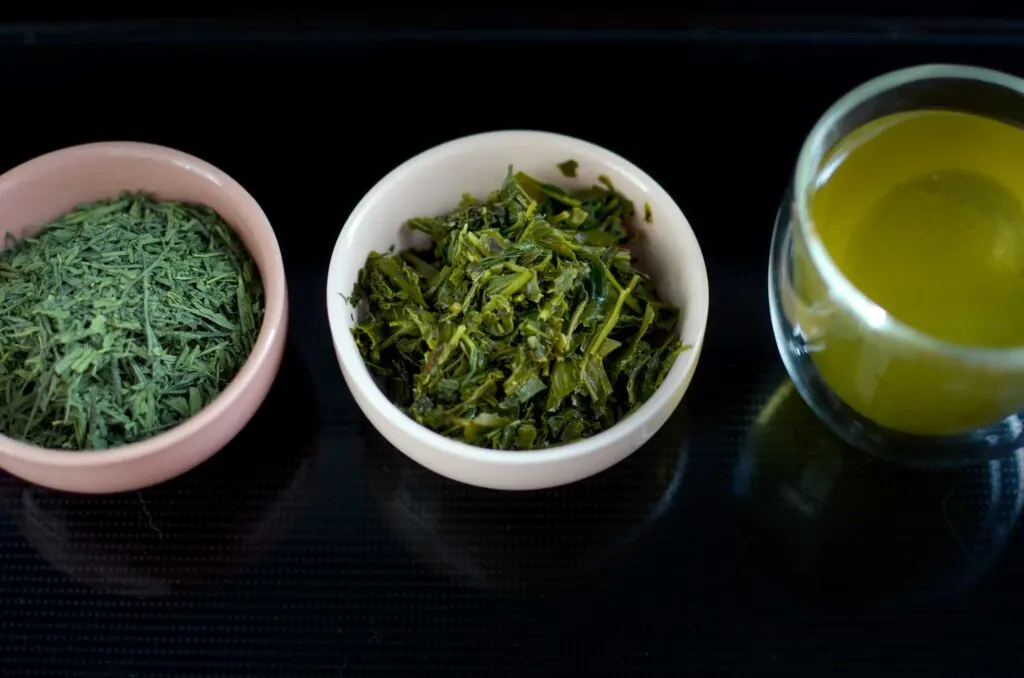
Tea Tasting Tips…
Also, don’t just focus on foods for what it smells and tastes like but everything. You can even think about how the tea makes you feel. Does it remind you of visiting lavender fields, or maybe your grandmothers house!?).
Take another sip – maybe try slurping it this time this time, and really leave it in your mouth to taste it all! Breath normally still with the tea in your mouth – do you notice anymore flavours opening up?
Swallow it… slowly… focus on the flavours as it goes down (and how it feels). After you’ve swallowed it, breath out through your nose again.
Take breaks between sips, but keep going back for more. Notice how the taste might change as the water cools down as well. If you’re up for it, maybe try retronasal olfaction (breath out through your nose while drinking the tea).

4. Analyze The Change
Remember, it’s easy to compare so this step is all about noticing the difference. Start off with the different between sips. Next, Smell the empty cup again – how does it smell now? If it’s a high in mineral tea, the smell should linger in the cup for a while.
Take a look at the wet leaf now and noticed how they’ve changed – perhaps they’re the same? Or they’ve opened up even more. If they aren’t fully opened up yet, there’s still brews left in the leaf.
Why not touch it or even try to open it up. How full is the leaf?
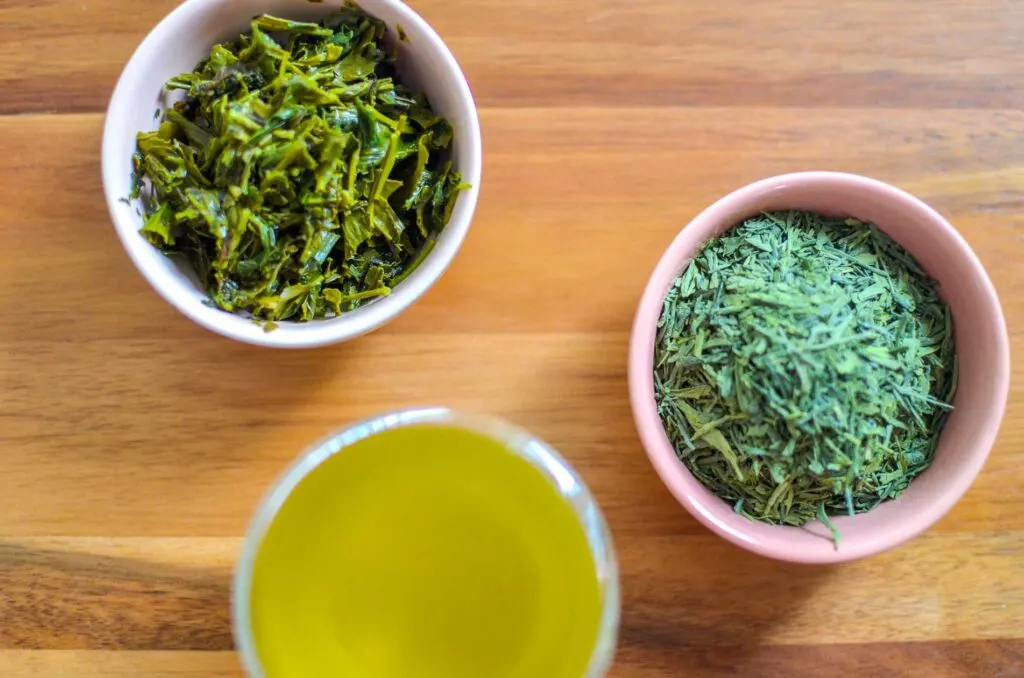
5. Optional: Second Brew
Have a few infusions to really notice the difference. Now you can also look at how the colour has changed from the first to the second brew.
But also the taste will be very different between infusions – are they getting weaker? What about the leaf?
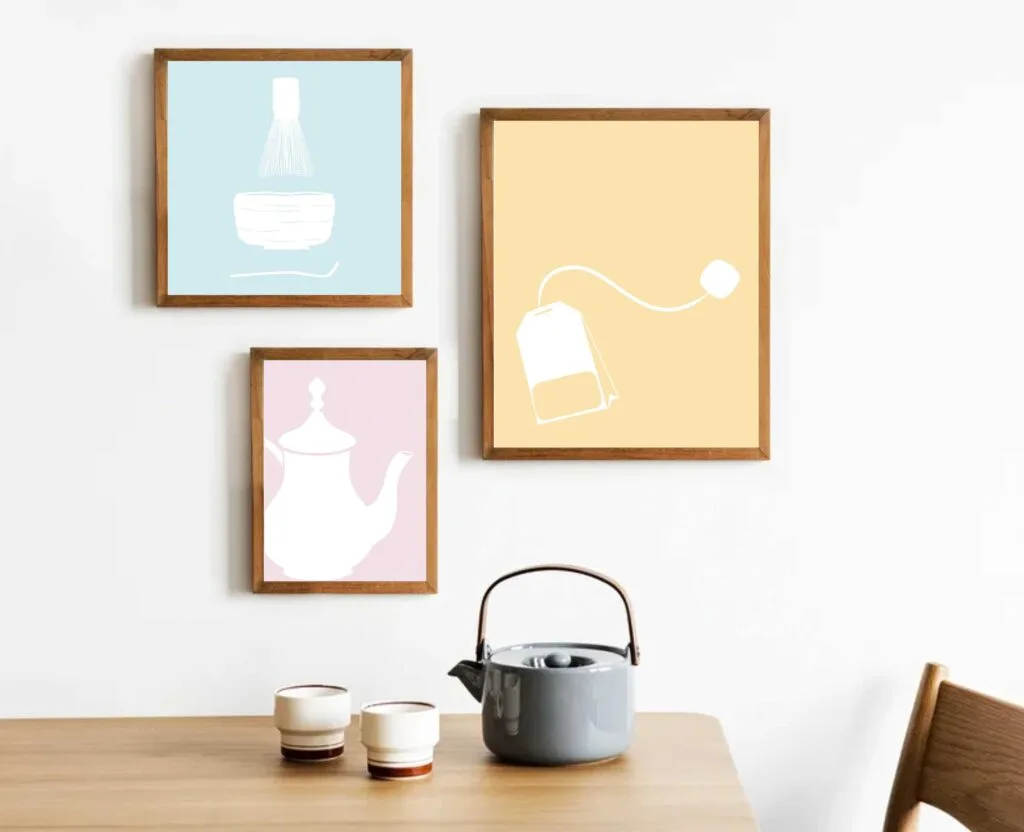
Minimalist Tea Wall Art For Your Home
Decorate your home with printable minimalist tea art. Wall art digital downloads that you frame yourself include 10 prints of different styles of tea.
Tastes Of Tea
Tasting tea goes way beyond flavours and aromas. It’s all about how the tea makes you feel, does it remind you of anything. It’s about personal experiences, not just technical tastes.

Flavours
How does the tea taste to you? You can first decide if it’s bitter, sweet, acidic..etc. Then delve deeper into the flavours. Is it herbal, vegetal, woodsy, spicy, fruity, citrusy, tropical, nutty, or floral…etc.
Then within each of these categories, go even deeper into what the tea tastes likes. For example, what flower or fruit does it taste like more specifically?
Tea Tasting Notes & Guide
You might be interested in my digital and printable tea tasting notes & guide to take your tea tasting to the next level. See it on Etsy.
Aromas
Aromas are what you smell. You can use the same tea tasting wheel (like this one on Etsy) for flavour and aroma guidance.

What Is The Mouthfeel & How The Tea Looks
Like I said, a tea tasting isn’t only about actually tasting tea. Look at the tea, what colour is it? Once you taste it, you’ll also want to take notes on how it feels in your mouth – is it thick? Light? Does the taste linger…?

Keep Track Of Your Teas
Never forget the tea in your cupboard with my printable & digital tea tracker. Comes in a visual cupboard design or list view!
How Does It Make You Feel
At the end of the tea, every tea will make you feel a certain way, and a tea tasting is also very much about how we feel.
Does it make you feel good: happy, more energized…? Or maybe it doesn’t make you feel so well: light headed, sweating …etc.
At this stage, take note of it if reminds you have anything the tea as well. Perhaps a specific memory? It’s about connecting with yourself, your past and present!
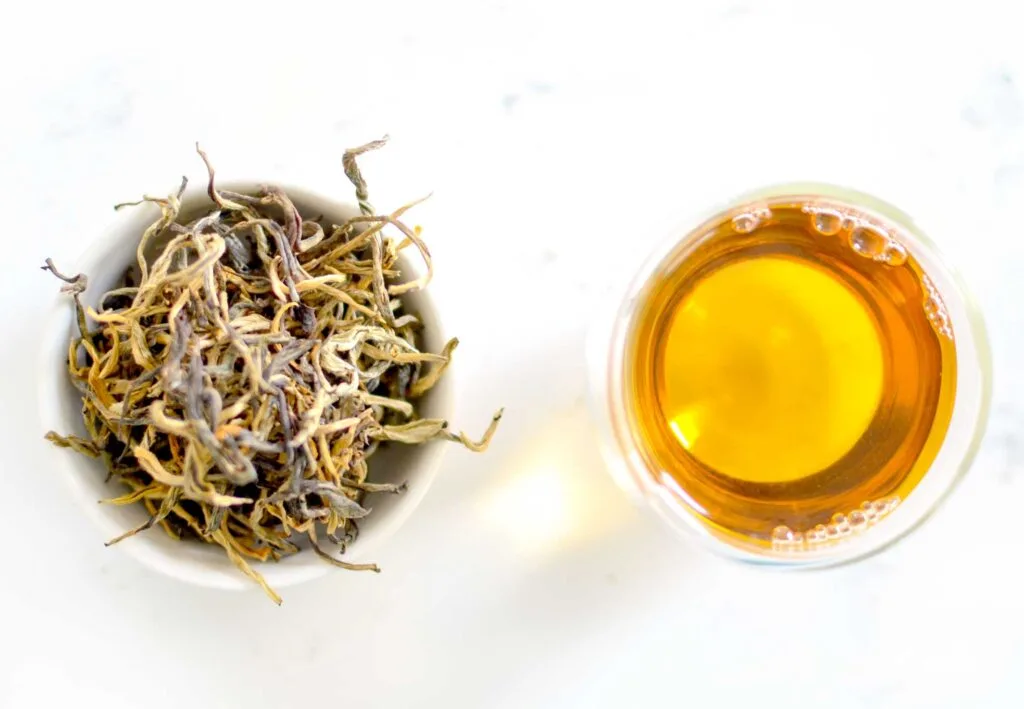
Have A Tea Tasting Guide & Journal
As I said, it’s always easier to compare than to come up with something new. When you’re just started out tasting tea, have a guide with some tasting notes you can reference (like this one on Etsy that I made).
It gives examples for every tea flavour and aroma. Plus, a second page comes with examples for the shape of the leaf, textures and mouthfeel, and how it could make you feel after drinking it.
Add to your tea tasting experience with a tea tasting journal (on Etsy here) as well to remember your experience. Take notes on every tea you taste to continuously improve your tea tasting skills. Plus, this way you’ll have a reference of every tea you’ve tried!
You can also buy both as a tea tasting bundle, see the bundle on Etsy here.

Quick Links – My Amazon Tea Favourites
Related Posts
- How To Make Tea – Brew The Perfect Cup Every Time!
- Finding The Best Earl Grey Tea: A Comparison Between Popular Tea Brands
- 11 Best Tea Books Every Tea Lover Needs In Their Tea Book Collection
- Top 10 Best Teas For Anxiety To Stay Calm & Stress Free!
- Tea Basics: The Different Types Of Teas Explained
Click Image To Share Or Save Post For Later
Last update on 2025-05-28 / Affiliate links / Images from Amazon Product Advertising API








